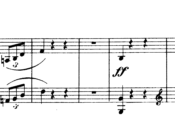Analysis
Contents
Prelude
SUMMARY:
This prelude is built mainly upon the quaver (eighth note) and semiquaver (sixteenth note) figure as seen above.
Bars 1-12: Period I. Ending with Perfect Cadence in the Relative Major, E flat, double bar and repeat.
Bars 12-28: Period II. Starting in the Relative major, passing through the related keys, C minor, A flat major, and F minor, before ending in the Tonic.
REMARKS:
This Prelude is simple in construction, and is divided into two nearly equal halves by the double bar.
In the first half the two figures which appear in Bar 1 are most employed. The figure in semiquavers (sixteenth notes) (Bar 1, upper part) gains in force by the use of dissonant passing notes which appears as the third in the group of four.
At Bar 2 the figures employed in Bar 1 change places.
At Bar 7 a new figure is momentarily introduced in the Treble.
Period II starts in the Relative Major using a free version of the upper figure of Bar 1.
At Bar 14 a new ornamental figure is placed in the upper part, the lower part meantime being a free version of the upper part of the previous bar, taken in contrary motion.
Sequential work is prominent throughout this Prelude.
Bars 6,7 are in a descending Sequence with Bar 5.
Bar 15,16 are in Sequence with Bars 13,14, the upper part being transposed a 5th lower, and the lower part a 4th higher.
Bar 20 is in a descending Sequence with Bar 10.
Bars 24,25 are in a descending Sequence with Bar 23.
Fugue
ANALYSIS:
ENUNCIATION SECTION:
Bars 1-2: Subject in Alto [C minor].
Bars 2-3: Tonal Answer in Treble. No Counter-subject [G minor].
Bars 3-4: Codetta, modulating from G minor to C minor.
Bars 4-5: Subject in Tenor [C minor].
Bars 5-7: Codetta, modulating from G minor, through G minor, F minor, and back again to C minor.
Bars 7-8: Answer in Bass [C minor].
Bars 8-9: Subject in Treble [C minor].
Bars 10-11: Answer in Alto.
MODULATORY SECTION:
Bars 11-12: Subject in Bass [F minor].
Bars 14-15: Subject in Treble [C minor].
Bars 14-16: Stretto I, Subject in Alto in Augmentation [C minor].
Bars 15-16: Answer in Tenor by Free Imitation [C minor].
Bars 16-17: Answer in Alto [G minor].
Bars 16-17: Subject in Treble [G minor].
Bars 17-18: Subject in Tenor [C minor].
Bars 17-18: Answer in Treble [A flat major].
Bars 19-21: Subject in Bass in Augmentation [C minor].
Bars 19-20: Subject in Treble by Inversion [C minor].
Bars 21-22: Answer in Bass by Inversion [C minor].
Bars 22-23: Subject in Bass [C minor].
RECAPITULATORY SECTION:
Bars 23-24: Stretto II, Subject in Alto [C minor].
Bars 23-24: Answer in Treble [C minor].
Bars 24-25: Subject in Treble [F minor].
Bars 26-27: Subject in Tenor [F minor].
Bars 26-27: Answer in Bass by Free Inversion [C minor].
Bars 27-28: Coda.
SUMMARY
Exposition: Bars 1-8.
Codettas: Two.
Counter-exposition: Bars 8-11 (incomplete).
Counter-subject: None.
Stretti: Two (both incomplete).
REMARKS:
- This Fugue has a “tonal” Answer, and would be called a “tonal” Fugue. The alteration in the Answer, for the sake of tonality, is made from the first note to the second.
- The device of Augmentation of the Subject is used on two occasions, while that of Inversion of the Subject and Answer is used four times. The earliest example of Augmentation occurs in Bar 14, and of Inversion in Bar 15.
- Stretto I commences with the Treble (Bar 14) and is immediately followed by the Alto in Augmentation an octave below at the distance of a quaver (eighth note) only. After the fourth note of the Alto Subject the Tenor enters with the Answer by Free Inversion (Bar 15). The last half of this Stretto appears at Bars 16-20. At Bar 19 the Bass reproduces the Alto of Bar 14 – i.e. in Augmentation, the Treble using the Subject by Inversion at the same time.
- Stretto II commences with the Alto (Bar 23), followed by the Trebe at the distance of a crotchet (quarter note). At Bar 26 the Bass in Stretto with the Tenor uses the Subject by Free Inversion.








